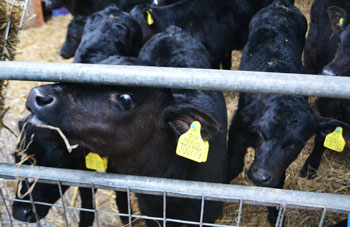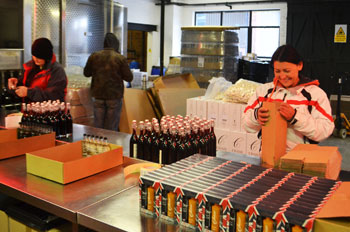If distilleries were people, Chase would be that guy at school who you liked despite him being naturally good at sport and popular with the ladies.

As a company, they have achieved the seemingly impossible – successfully launching new products into the most cluttered of spirit sectors: vodka and gin. And they have done so without a multi-million pound marketing budget or celebrity endorsements.
Curious to know more about Chase and how they managed to become such a back bar staple in five years, we gratefully accepted an invitation to spend a couple of days on their Herefordshire farm.
Arriving at the farm on a ball-shrinkingly cold day, we strolled around the fields, admiring the English countryside at its finest (rolling fields, cows, frost, poo), while James Chase gave us a quick history of his family’s entry into the spirit world.
Formerly producing the excellent Tyrells crisps with potatoes grown on the farm, a fortuitous distillery tour in Pennsylvania introduced Chase patriarch, William, to a new use for his crop.
William immediately began putting together plans for his own unique distillery – one that would keep the entire production chain in-estate, from seed to bottle.

In 2008, the first batch of Chase vodka came off the still, made entirely from produce grown on the farm. And remarkably it still is – the mash comes from Lady Clare and Lady Rosetta potatoes harvested from the fields surrounding the farm.
At this stage we were very happy to enter the warm and fantastic-smelling interior of the distillery, where Alex Davies, Chase’s youthful gin and vodka distiller, showed us the ropes.
From harvest, potatoes are taken to a state of the art cold storage facility where they are kept dormant at 2 degrees centigrade for use throughout the year (one reason why potato vodka is so uncommon – spuds are expensive to store).
They then enter a peeling line before being sent to the mash vessels to be broken down both mechanically and enzymatically to form a rather sweet and very pungent liquid mash.
The mash is then fermented to dryness for up to a week in order to produce a potato wine at around 10% ABV. The fermented mash is then sent through a stripping column, which separates the alcohol from the mash to produce a low wine.
The low wines are distilled to up to 96.5% through a column – the tallest rectification column in the world – standing at 20m high with 42 bubble plates.

At 96%, the vodka is sent to a 400 liter Carter-Head still where it is diluted with fresh water drawn from an on site bore hole, and redistilled through the Carter-Head still, now containing botanicals. The Carter-Head gently bathes botanicals in vapour, teasing out delicate flavours and volatiles.
Alex runs the still slowly, at 60 liters an hour, before cutting the tails at 65% (the tails are added to the start of the next batch in order to enhance the intensity of the distillate) before blending the distillate down to 40% or 48% with water, again from the farm’s borehole) before doing all of the bottling in house.
Having watched each part of the distilling process in action, it was time for a tasting, and to be honest we were slightly intimidated by the number of bottles lined up. I personally hadn’t realised just how many different varieties Chase produced.
Working through the range, we were struck by how great all of the flavoured vodkas tasted. In particular the rhubarb vodka was a knockout, with Simon Webster (who admittedly has been know to drink turps from time to time) saying it was one of the best spirits he had tasted that year (2012).

I myself was very taken with the 48% William Chase gin, made from organic apples grown on the farm, which has subsequently become my Martini gin of choice.
Of course, there are many distillers who pour passion and commitment to quality into their products, however Chase seem to disregard factors like production cost and ‘easiness’.
We asked William about this, and he told us:
“We’ve been very frustrated at how easily people can create a gin using neutral grain spirit and behave as if the flavour of the spirit is not important.
We could use neutral spirit too – it would be a tenth of the cost – but we want people to understand that gin is made from vodka and therefore have to make the best possible vodka in the first place, which is why we use our own potato and apple vodka as the basis for our gins. It has always been our mission to say that vodka has flavour.
Also focusing on our green credentials, its a little know fact that a lot of the neutral spirit in the UK is brought in from as far away as Brazil where commodities are cheap.”

Given the quality of their products, one can understand why Chase have gone down this road. It’s seems to be working conceptually too, with bartenders warming quickly and loyally to their booze. The Rock the Farm festival for bartenders, held once a year on the Chase farm, probably doesn’t hurt in this respect.
If you are given the opportunity to visit the Chase distillery, take it. You may have done a dozen distillery tours before, but this one is pleasingly different (funky smells coming from the cowshed aside), it is great to see the distillation process, normally spread between different sites and in many cases countries, happen in its entirety on one farm.
As of April 2013, Chase vodka and Williams gin will be distributed throughout the UK by Cellar Trends.


